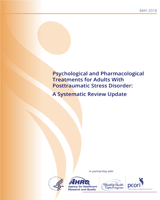From: Results

NCBI Bookshelf. A service of the National Library of Medicine, National Institutes of Health.
| Study | Arm Dose mg/Day (N) | Duration (Weeks) | Population Trauma Type | Baseline PTSD Severity | Mean Age (Y) | % Female | % Non-white | Risk of Bias |
|---|---|---|---|---|---|---|---|---|
| Becker et al., 2007183 | Total 30a Bupropion 100 to 300 mg (18) Placebo (10) | 8 | Male and female Mixed | NR | 50 | 21 | 71 | Medium |
| Davidson et al., 2003184 | Total 29b Mirtazapine 15 to 45 mg (17) Placebo (9) | 8 | Male and female Mixed | SPRINT 21.7 to 25.0 | 46 | NR | NR | Medium |
Thirty subjects were randomized; exact numbers randomized to each group NR; authors reported that 18 received bupropion and 10 received placebo; 2 dropped out prior to treatment.
A total of 29 subjects were randomized: 3 subjects dropped out early, 17 received mirtazapine, and 9 received placebo.
Note: When mean data for baseline PTSD severity were not reported for the total sample but were presented for each study arm, we provide the range across arms.
F = female; mg = milligram; N = total number randomized/assigned to intervention and control groups; NR = not reported; PTSD = posttraumatic stress disorder; SPRINT = Short PTSD Rating Interview; y = year.
From: Results

NCBI Bookshelf. A service of the National Library of Medicine, National Institutes of Health.